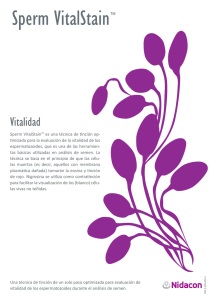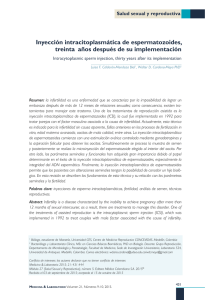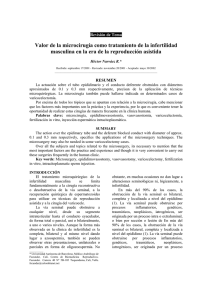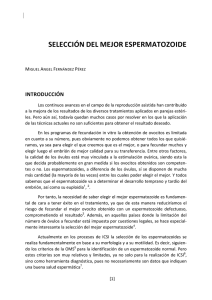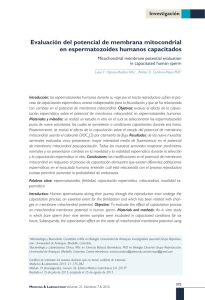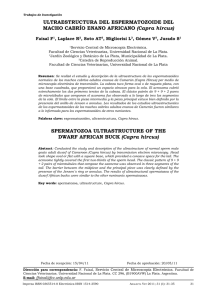Interacción entre los espermatozoides y el tracto
Anuncio
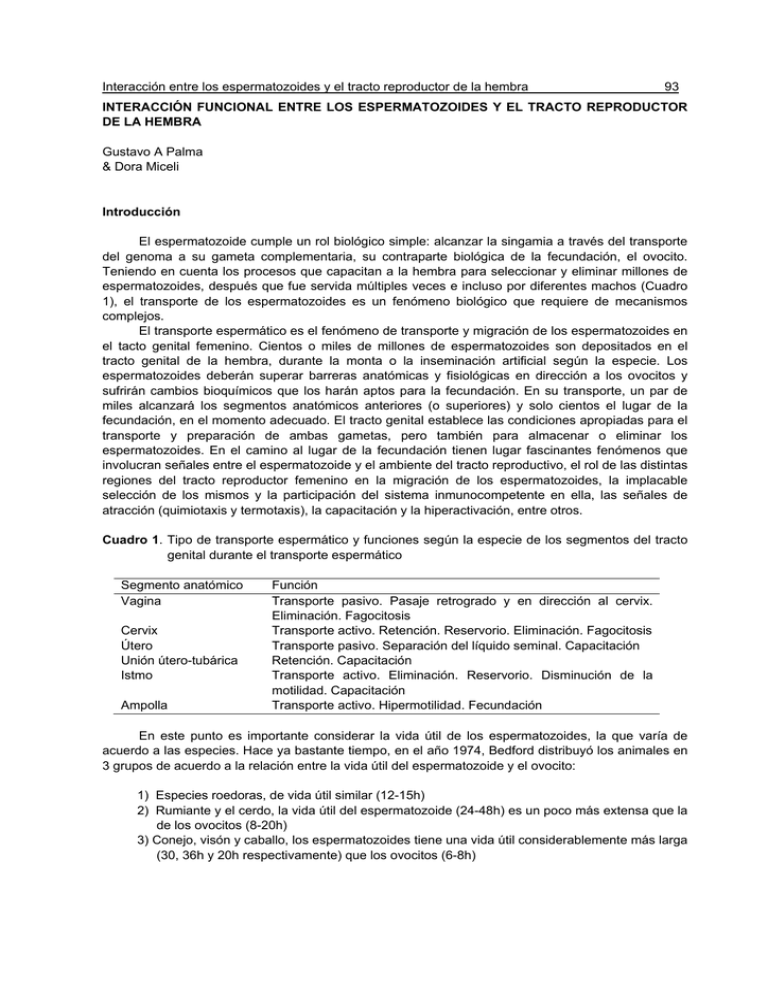
Interacción entre los espermatozoides y el tracto reproductor de la hembra 93 INTERACCIÓN FUNCIONAL ENTRE LOS ESPERMATOZOIDES Y EL TRACTO REPRODUCTOR DE LA HEMBRA Gustavo A Palma & Dora Miceli Introducción El espermatozoide cumple un rol biológico simple: alcanzar la singamia a través del transporte del genoma a su gameta complementaria, su contraparte biológica de la fecundación, el ovocito. Teniendo en cuenta los procesos que capacitan a la hembra para seleccionar y eliminar millones de espermatozoides, después que fue servida múltiples veces e incluso por diferentes machos (Cuadro 1), el transporte de los espermatozoides es un fenómeno biológico que requiere de mecanismos complejos. El transporte espermático es el fenómeno de transporte y migración de los espermatozoides en el tacto genital femenino. Cientos o miles de millones de espermatozoides son depositados en el tracto genital de la hembra, durante la monta o la inseminación artificial según la especie. Los espermatozoides deberán superar barreras anatómicas y fisiológicas en dirección a los ovocitos y sufrirán cambios bioquímicos que los harán aptos para la fecundación. En su transporte, un par de miles alcanzará los segmentos anatómicos anteriores (o superiores) y solo cientos el lugar de la fecundación, en el momento adecuado. El tracto genital establece las condiciones apropiadas para el transporte y preparación de ambas gametas, pero también para almacenar o eliminar los espermatozoides. En el camino al lugar de la fecundación tienen lugar fascinantes fenómenos que involucran señales entre el espermatozoide y el ambiente del tracto reproductivo, el rol de las distintas regiones del tracto reproductor femenino en la migración de los espermatozoides, la implacable selección de los mismos y la participación del sistema inmunocompetente en ella, las señales de atracción (quimiotaxis y termotaxis), la capacitación y la hiperactivación, entre otros. Cuadro 1. Tipo de transporte espermático y funciones según la especie de los segmentos del tracto genital durante el transporte espermático Segmento anatómico Vagina Cervix Útero Unión útero-tubárica Istmo Ampolla Función Transporte pasivo. Pasaje retrogrado y en dirección al cervix. Eliminación. Fagocitosis Transporte activo. Retención. Reservorio. Eliminación. Fagocitosis Transporte pasivo. Separación del líquido seminal. Capacitación Retención. Capacitación Transporte activo. Eliminación. Reservorio. Disminución de la motilidad. Capacitación Transporte activo. Hipermotilidad. Fecundación En este punto es importante considerar la vida útil de los espermatozoides, la que varía de acuerdo a las especies. Hace ya bastante tiempo, en el año 1974, Bedford distribuyó los animales en 3 grupos de acuerdo a la relación entre la vida útil del espermatozoide y el ovocito: 1) Especies roedoras, de vida útil similar (12-15h) 2) Rumiante y el cerdo, la vida útil del espermatozoide (24-48h) es un poco más extensa que la de los ovocitos (8-20h) 3) Conejo, visón y caballo, los espermatozoides tiene una vida útil considerablemente más larga (30, 36h y 20h respectivamente) que los ovocitos (6-8h) 94 Palma & Miceli El conocimiento de las bases biológicas de la interacción entre el espermatozoide y el tracto genital femenino permitirá comprender las derivaciones y consecuencias biotecnológicas del transporte espermático al lugar de la fecundación, cómo inciden los tratamientos hormonales o el sexado del semen sobre la fecundación. El conocer mejor los mecanismos permitirá, por ejemplo, orientar el desarrollo biotecnológico para lograr emplear solamente las poblaciones de células espermáticas más competentes, reducir su concentración entre 500 y 5000 veces, alcanzando tasas de preñez superior a 60% y, diseñar nuevos métodos para mejorar la eficiencia de la reproducción. La paradoja del proceso reproductor Porqué miles de millones de espermatozoides si solo se necesita uno? La selección de los espermatozoides basa su existencia y su éxito en la heterogeneidad de la población celular. La eliminación selectiva de las células espermáticas con anomalías de la cabeza, del acrosoma o el flagelo fueron ampliamente difundidas, pero el actual concepto de selección no se limita a las anomalías o la inmovilidad, sino que funda su acción en el control del éxito o fracaso de cada uno de los procesos bioquímicos, biofísicos y metabólicos necesarios para que los espermatozoides alcancen la fecundación. Además de la motilidad, los patrones de movimiento flagelar, la velocidad diferencial (activación e hiperactivación), el equilibrio osmótico, la capacitación, la integridad de los receptores termo- y quimiotácticos, de los péptidos de membrana, como de los canales de Ca2+ y de la función de la PKA, provocan que se forme una reducida y altamente selecta población de espermatozoides capaces de fecundar. El resultado de esta gradual e implacable reducción conduce a la razonable conclusión de que la mayoría de los espermatozoides no están en condiciones de lograr los cambios necesarios y que la población apta puede tener una importancia colectiva en el momento de la fecundación, (Holt y Van Lock, 2004). Ello explica porqué la relación entre los estudios de morfología y motilidad, antes de la congelación o después de la descongelación, con las tasas de gestación son controvertidas. De la misma forma, explica porqué, salvo en la especie bovina, la criopreservación y actualmente el sexado de espermatozoides por medio de citometría de flujo, afectan significativamente la integridad celular (Palma y col., 2006) y disminuyen consecuentemente las tasas de gestación en la mayoría de la especies. Por esa razón, se crea la necesidad de eludir barreras anatómicas a través de la inseminación intrauterina o uterotubárica (Holt y col., 2006), para reducir el tiempo de transporte, sortear las células inmunitarias, ofrecer condiciones oviductales benignas y mejorar las tasas de gestación, pero como eso es solo un paso en el complejo derrotero de la selección de los espermatozoides durante el transporte y migración (Lyons y col., 2005), las tasas de gestación solo alcanzarán a las óptimas cuando se obtengan pequeñas poblaciones pero más adecuadas para sobrevivir a los cambios necesarios para una fecundación exitosa. Interacción entre los espermatozoides y el tracto reproductor de la hembra 95 Bibliografía Alvarez JG, Touchstone JC, Blasco L, BT Storev (1987) Spontaneous lipid peroxidation and production of hydrogen peroxide and superoxide in human spermatozoa Androl 8, 338-348 Atrial Natriuretic Peptide: A Chemoattractant of Human Spermatozoa by a Guanylate CyclaseDependent Pathway (1995) Anderson Jr RA, Feathergill KA, Rawlins RG, Mack SR and LJD Zaneveld Mol Reprod Devel 40, 371-378 Arnoult C, Kazam IG, Visconti PE, Kopf GS, Villaz M and HM Florman (1999) Control of the low voltage-activated calcium channel of mouse sperm by egg ZP3 and by membrane hyperpolarization during capacitation PNAS 96, 6757–6762 Arnoult C, Cardullo RA, Lemos JR and HM Florman (1996) Activation of mouse sperm T-type Ca2+ channels by adhesion to the egg zona pellucida PNAS 93 13004–13009 Austin CR (1952) The 'capacitation' of the mammalian sperm Nature 170, 326 (1952) Austin CR (1982) Sperm transport in the female tract. Site of semen deposition. In: Austin CR and RU Short (Eds) University Press, Cambridge, 109-111 67:1565–1571 Bahat A, Tur-Kaspa I, Gakamsky A, Giojalas LC, Breitbart H and M Eisenbach (2003) Thermotaxis of mammalian sperm cells: a potential navigation mechanism in the female genital tract, Nature Med 9, 149–150 Bahat A, Eisenbach M, I Tur-Kaspa (2005) Periovulatory increase in temperature difference within the rabbit oviduct Hum Reprod 20, 2118-21 Bahat A and M Eisenbach (2006) Sperm thermotaxis Mol Cell Endocrinol 252, 115-119 Bedford JM (1974) Maturation of the fertilizing ability of ammalian spermatozoa in males and female reproductive tract Biol Reprod 11, 346-362 Bedford JM and R Yanagimachi (1992) Initiation of sperm motility after mating in the rat and hamster. J Androl 13,444–449 Bigelow JL, Dunson DB, Stanford JB, Ecochard R, Gnoth C and B Colombo (2004) Mucus observations in the fertile window: a better predictor of conception than timing of intercourse Hum Reprod 19, 889–892 Blandau JR and UPGaddum-Rosse (1974) Mechanism to sperm transport in pig oviducts Fertil Steril 25, 61-67 Breitbart H, Cohen G and S Rubinstein (2005) Role of actin cytoskeleton in mammalian sperm capacitation and the acrosome reaction Reproduction 129, 263–268 Breitbart H, Rubinstein S, N Etkovitz (2006) Sperm capacitation is regulated by the crosstalk between protein kinase A and C Mol Cell Endocrinol 252, 247–249 Brewis IA, Moore HD, Fraser LR, Holt WV, Baldi E, Luconi M, Gadella BM, Ford WC and RA Harrison (2005) Molecular mechanisms during sperm capacitation Hum Fertil (Camb) 8, 253-261 Burgess SA, Walker ML, Sakakibara H, Knight PJ, Oiwa K (2003) Dynein structure and power stroke Nature 421, 715–718 Campbell MLH and GCW England (2002) A comparison of the ecbolic efficacy of intravenous and intrauterine oxytocin treatments Theriogenology 58, 473–477 Carballada R and P Esponda (1997) Fate and distribution of seminal plasma proteins in the genital tract of the female rat after natural mating J Reprod Fertil 109, 325–335 Chang MC (1957) A Detrimental effect of seminal plasma on the fertilizing capacity of sperm Nature 179, 258-259 citado por Abney T0 and WL Williams (1970) Biol Reprod 2, 14-17 Inhibition of sperm capacitation by intrauterine deposition of seminal plasma decapacitation factor1 Card C (2005) Post-breeding inflammation and endometrial cytology in maresTheriogenology 64, 580–588 Carlson AE, Quill TA, Westenbroek RE, Schuh SM, Hille B, DF Babcock (2005) Identical phenotypes of CatSper1 and CatSper2 null sperm J Biol Chem 16, 32238-44 Cicinelli E, Einer-Jensen N, Barba B, Luisi D, Alfonso R and M Tartagni (2004) Blood to the cornual area of the uterus is mainly supplied from the ovarian artery in the follicular phase and from the uterine artery in the luteal phase Hum Reprod 19, 1003–1008 96 Palma & Miceli Clapham DE and DL Garbers (2005) Relationships of CatSper and Two-Pore Channels Pharmacol Rev 57, 451-454 Claus R (1990) Physiological role of seminal components in the reproductive tract of the female pig J Reprod Fertil Suppl 40,117–131 Cohen G, Rubinstein S, Gur Y, H Breitbart (2004) Crosstalk between protein kinase A and C regulates phospholipase D and F-actin formation during sperm capacitation Dev Biol 267, 230–241 Cohen-Dayag A, Ralt D, Tur-Kaspa I, Manor M, Makler A, Dor J, Mashiach S and M Eisenbach (1994) Sequential acquisition of chemotactic responsiveness by human spermatozoa Biol Reprod 50, 786–790 Cohen-Dayag A, Tur-Kaspa I, Dor J, Mashiach S and Eisenbach M (1995) Sperm capacitation in humans is transient and correlates with chemotactic responsiveness to follicular factors Proceedings of National Academy of Sciences USA 92, 11039–11043 Combs GB, LeBlanc MM, Neuwirth L, TQ Tran (1996) Effects of prostaglandin F2a, cloprostenol and fenprostalene on uterine clearance of radiocolloid in the mare Theriogenology 45, 1449–1455 Darszon A, Beltrán C, Felix R, Nishigaki T and CL Treviño (2001) Ion transport in sperm signaling Developmental Biology 240, 1–14 DasGupta S, CL Mills and LR Fraser (1994) A possible role for Ca2+-ATPase in human sperm capacitation J Reprod Fertil 102, 107-116 David A, Vilensky A H and Nathan (1972) Temperature changes in the different parts of the rabbit's oviduct. Int J Gynaec Obstet 10, 52–56 (citado por Bahat y col., 2005) Den Daas JG, De Jong Lansberger LM and AM Van Wagtendonk-De Leeuw (1998) The relationship between the number of spermatozoa inseminated and the reproductive efficiency of individual dairy bulls J Dairy Sci 81, 1714–1723 de Lamirande E, P Leclerc and C Gagnon (1997) Capacitation as a regulatory event that primes spermatozoa for the acrosome reaction and fertilization Mol Hum Reprod 3, 175-194 DeMott RP and SS Suarez (1992) Hyperactivated sperm progress in the mouse oviduct Biol Reprod 46,779–785 Eisenbach M (1999) Sperm chemotaxis Rev Reprod 4, 56–66 Eisenbach M (2004) Towards understanding the molecular mechanism of sperm chemotaxis J Gen Physiol 124, 105–108 Eisenbach M and I Tur-Kaspa (1999) Do human eggs attract spermatozoa? BioEssays 21, 203–210 Fabro G, Rovasio RA Civalero S, Frenkel A, Caplan SR, M Eisenbach and LC Giojalas (2002) Chemotaxis of capacitated rabbit spermatozoa to follicular fluid revealed by a novel directionalitybased assay Biol Reprod 67, 1565–1571 Felix R, Serrano CJ, Trevino CL, Munoz-Garay C, Bravo A, Navarro A, Pacheco J, Tsutsumi V and A Darszon (2002) Identification of distinct K þ channels in mouse spermatogenic cells and sperm Zygote 10, 183–188. Fraser LR, MC Pondel and GP Vinson (2001) Calcitonin, angiotensin II and FPP significantly modulate mouse sperm function Mol Hum Reprod 7, 245-253 Fraser LR and OO Osiguwa (2004) Human sperm responses to calcitonin, angiotensin II and FPP in prepared semen samples from normal donors and infertility patients Human Reprod 19, 596-606 Fraser LR, Adeoya-Osiguwa SA, Baxendale RW, and R Gibbons (2006) Regulation of mammalian sperm capacitation by endogenous molecules Front Biosci 11, 1636-1645 Gibbons R, SA Adeoya-Osiguwa and LR Fraser (2005) A mouse sperm decapacitation factor receptor is phosphatidylethanolamine-binding protein 1 Reproduction 130, 497-508 Götze R (1949) Besamung und unfruchtbarkeit der Haustiere / von Richard Götze Hannover (Verlag Schaper), Hannover - XII, 613 S Gutsche S, Wolff M von, Strowitzki T, CJ Thaler (2003) Seminal plasma induces mRNA expression of IL-1β, IL-6 and LIF in endometrial epithelial cells in vitro. Mol Hum Reprod 9, 785–791 Hafez ESE and H Kanagawa (1972) Ciliated epihtelium in the uterine cervix of the macaque and rabbit J Reprod Fertil 28, 91-94 Ho H-C, SS Suarez (2001a) An inositol 1,4,5-trisphosphate receptor-gated intracellular Ca2+ store is involved in regulating sperm hyperactivated motility Biol Reprod 65, 1606–1615 Interacción entre los espermatozoides y el tracto reproductor de la hembra 97 Ho H-C and SS Suarez (2001b) Hyperactivation of mammalian spermatozoa: function and Regulation Reproduction 122, 519–526 Holt WV, Elliott RM, Fazeli A, Sostaric E, Georgiou AS, Satake N, Prathalingam N and PF Watson (2006) Harnessing the biology of the oviduct for the benefit of artificial insemination Reprod Suppl 62, 247-59 Holt WV and KJW Look (2004) Concepts in sperm heterogeneity, sperm selection and sperm competition as biological foundations for laboratory test of semen quality Reproduction 127, 527535 Hunt AJ (1998) Molecular motors: keeping the beat Nature 393, 711-714 Hunter RHF (1981) Sperm transport and reservoirs in the pig oviduct in relation to the time of ovulation J Reprod Fertil 63,109–117 Hunter RHF and R Nichol (1983) Transport of spermatozoa in the sheep oviduct: preovulatory sequestering of cells in the caudal isthmus J Exp Zool 228,121–128 Hunter RHF (1993) Sperm:egg ratios and putative molecular signals to modulate gamete interactions in polytocous mammals Mol Reprod Dev 35, 324–327 Hunter RH (1995) Significance of the epithelial crypts at the bovine utero-tubal junction in the proovulatorio phase of sperm regulation Acta Vet Scand 36, 413-421 Hunter RHF (1998) Sperm–epithelial interactions in the isthmus and ampulla of the Fallopian tubes and their ovarian control. In: A Lauria, Gandolfi F, Enne G and L Gianaroli, Editors, Gamettes: Develoment and Function Serono Symposia Rome, 355–367 Hunter RHF, Cook B, NL Poyser (1983) Regulation of oviduct function in pigs by local transfer of ovarian steroids and prostaglandins: a mechanism to influence sperm transport Eur J Obstet Gynecol Reprod Biol 14, 225–232 Hunter RHF (2001) New breeding opportunities with deep cornual insemination: exploiting modern sperm technologies in cattle Reprod Dom Anim 36, 217–222. Hunter RHF (2003) Advances in deep uterine insemination: a fruitful way forward to exploit new sperm technologies in cattle Anim Reprod Sci 79, 157–170 Hunter RHF (2005) The falopian tubes in domestic mammals:how vital is their physiological activity? Reprod Nutr Dev 45, 281-290 Hunter RHF and T Greve (1998) Deep uterine insemination of cattle: a fruitful way forward with smaller numbers of spermatozoa Acta Vet Scand 39 149–163 Hunter RHF and R Nichol (1986) A preovulatory temperature gradient between the isthmus and the ampulla of pig oviducts during the phase of sperm storage J Reprod Fert 77, 599–606 Hurtgen JP (2006) Pathogenesis and treatment of endometritis in the mare: a review Theriogenology 66, 560-566 Jagannathan S, Publicover SJ and CL Barratt (2002) Voltage-operated calcium channels in male germ cells Reproduction 123, 203–215 Jin JL, O’Doherty AM, Wang S, Zheng H, Sanders KM and W Yan (2005) Catsper3 and catsper4 encode two cation channel-like proteins exclusively expressed in the testis Biol Reprod 73, 1235– 1242 Katz DF, Morales P, Samuels SJ and Overstreet JW (1990) Mechanisms of filtration of morphologically abnormal human sperm by cervical mucus Fertil Steril 54,513–516 Katz DF, Slade DA and Nakajima ST (1997) Analysis of preovulatory changes in cervical mucus hydration and sperm penetrability Adv Contracep 13, 143–151 Kayisli UA, Mahutte NG, A Arici (2002) Uterine chemokines in reproductive physiology and pathology Am J Reprod Immunol 47, 213-21 Kayisli UA, Guzeloglu-Kayisli O, A Arici (2004) Endocrine-immune interactions in human endometrium Ann N Y Acad Sci 1034, 50-63 Kim NN, Min K, Pessina MA, Munarriz R, Goldstein I, Traish AM (2004) Effects of ovariectomy and steroid hormones on vaginal smooth muscle contractility Int J Impot Res 16, 43-50 King SM (2000) The dynein microtubule motor Bioch Biophy Acta (BBA) 1496, 60-75 Kirichok Y, Navarro B, and DE Clapham (2006) Whole-cell patch clamp measurements of spermatazoa reveal an alkaline-activated Ca2_ channel. Nature (Lond), en prensa 98 Palma & Miceli Kurykin J, Jaakma U, Waldmann A, Jalakas M, Aidnik M, Majas L, P Padrik (2006) Low semen dose intracornual insemination of cows at fixed time after PGF2alpha treatment or at spontaneous estrus Anim Reprod Sci, 95(1-2): 116-124 Lilja H and A Lundwall (1992) Molecular cloning of epididymal and seminal vesicular transcripts encoding a semenogelin-related protein Proc Natl Acad Sci USA 89, 4559–4563 Lindemann CB (1994) A Geometric Clutch hypothesis to explain oscillations of the axoneme of cilia and flagella J Theor Biol 168, 175–189 Lindemann CB (2003) Structural-functional relationships of the dynein, spokes, and central-pair projections predicted from an analysis of the forces acting within a flagellum Biophys J 84, 41154126 Lobley A, Pierron V, Reynolds L, Allen L and D Michalovich (2003) Identification of human and mouse CatSper3 and CatSper4 genes: Characterisation of a common interaction domain and evidence for expression in testis Reprod Biol Endocrinol 1, 53–67 Luck MR, Griffiths S, Gregson K, Watson E, Nutley M and A Cooper (2001) Follicular fluid responds endothermically to aqueous dilution Hum Reprod 16, 2508–2514 Lyons RA, Saridogan E and O Djahanbakhch (2005) The reproductive significance of human fallopian tube cilia Hum Reprod Upd 12, 363-372 McDonand LE (1978) Reproducción y endocrinología Veterinarias (Ed Interamericana) Madill S, Troedsson MHT, Santschi EM, ED Malone (2002) Dose response effect of intramuscular oxytocin treatment on myometrial contraction of reproductively normal mares during estrus Theriogenology 58, 479–481 Marquez B, SS Suarez (2004) Different signaling pathways in bovine sperm regulate capacitation and hyperactivation Biol Reprod 70, 1626-33 Mazarakis ND, Nelki D, Lyon MF, Ruddy S, Evans EP, Freemont P and K Dudley (1991) Isolation and characterisation of a testis-expressed developmentally regulated gene from the distal inversion of the mouse t-complex Development 111, 561–571 McMaster MT, Newton RC, Dey SK and GK Andrews (1992) Activation and distribution of inflammatory cells in the mouse uterus during the preimplantation period. J Immunol 148, 1699– 1705 Menezo Y and P Guerin (1997) The mammalian oviduct: Biochemistry and physiology Eur J Obstet Gynecol Reprod Biol 73, 99–104 Mombaerts P (2004) Genes and ligands for odorant, vomeronasal and taste receptors Nat Rev Neurosci 5, 263–278 Moore HD, Martin M and TR Birkhead (1999) No evidence for killer sperm or other selective interactions between human spermatozoa in ejaculates of different males in vitro Proceedings of the Royal Society of London Series B, 266, 2343 – 2350 Moore H, Dvorakova K, Jenkins N and W Breed (2002) Exceptional sperm cooperation in the wood mouse Nature 418, 174 – 177 Moore T and HD HD Moore (2002) Marsupial sperm pairing: a case of sticky green beards? Trends in Ecol Evol 17, 112 – 113 Mueller A, Siemer J, Schreiner S, Koesztner H, Hoffmann I, Binder H, Beckmann MW and R Dittrich (2006) Role of estrogen and progesterone in the regulation of uterine peristalsis: results from perfused non-pregnant swine uteri Hum Reprod Hum Reprod 21, 1863-1868 Mullins KJ and Saacke RG (1989) Study of the functional anatomy of bovine cervical mucosa with special reference to mucus secretion and sperm transport Anat Rec 226,106–117 Neuwald AF, Aravind L, Spouge JL, Koonin EV (1999) AAA+: A class of chaperone-like ATPases associated with the assembly, operation, and disassembly of protein complexes Genome Res 9, 27– 43 Nikolakopoulos E, Kindahl H, ED Watson (2000) Oxytocin and PGF2a release in mares resistant and susceptible to persistent matinginduced endometritis J Repro Fértil 56,363–372 Nixon B, MacIntyre DA, Mitchell LA, Gibbs GM, O'Bryan M and RJ Aitken (2006) The identification of mouse sperm-surface-associated proteins and characterization of their ability to act as decapacitation factors Biol Reprod 74, 275-287 Interacción entre los espermatozoides y el tracto reproductor de la hembra 99 Ofer Lavie MD, Ehud J, Margalioth MD, Talia Geva-Eldar MD and MD Avraham Ben-Chetrit (1997) Ultrasonographic endometrial changes after intrauterine insemination: a comparison of two catheters Fert Steril 68, 731-734 Oliveira RG, Tomasi L, Rovasio RA and LC Giojalas (1999) Increased velocity and induction of chemotactic response in mouse spermatozoa by follicular and oviductal fluids JReprod Fertil 115, 23–27 Overstreet JW, Cooper GW and DF Katz (1980) Motility of rabbit spermatozoa in the secretions of the oviduct Biol Reprod 19, 1083-1088 Palma GA (1986) Spermienückgewinung aus dem weiblichen Genitale des Kaninchens nach Insemination vom Frisch- und Tiefgerfriersperma Tierärztliche Hochschule Hannover, Deutschland, PhD-Dissertation, 1-98 Palma GA, Olivier N, Ch Neumüller and F Sinowatz (2006) Effects of sex-sorted spermatozoa on the efficiency of in vitro fertilization and ultrastructure of in vitro produced bovine blastocysts Anat Hystol Embryol (en prensa) Patapoutian A, Peier AM, Story GM and V Viswanath (2003) ThermoTRP channels and beyond: mechanisms of temperature sensation Nat Rev Neurosci 4, 529–539 Pekzold R (2001) Akzessorisches Sekret In: Veterinärmedizinische Andrologie, Physiologie und Pathologie der Fortpflanzung bei männlichen Tieren, Schattauer, Berlin-Wein, 55-66 Purohit SB, Laloraya M and GP Kumar (1999) Role of ions and ion channels in capacitation and acrosome reaction of spermatozoa Asian Journal of Andrology 1, 95–107 Quill TA, Sugden SA, Rossi KL, Doolittle LK, Hammer RE and DL Garbers (2003) Hyperactivated sperm motility driven by CatSper2 is required for fertilization Proc Natl Acad Sci USA 100,14869– 14874 Ren D, Navarro B, Perez G, Jackson AC, Hsu S, Shi Q, Tilly JL and DE Clapham (2001) A sperm ion channel required for sperm motility and male fertility Nature 413, 603–609. Robert M and C Gagnon (1999) Semenogelin I: a coagulum forming, multifunctional seminal vesicle protein Cell Mol Life Sci 55, 944-60 Robertson SA (2005) Seimianl plasma and male factor signaling in the famale reproductive tract Cell Tissue Res 322, 43-52 Robertson SA, Mau VJ, Tremellen KP, RF Seamark (1996) Role of high molecular weight seminal vesicle proteins in eliciting the uterine inflammatory response to semen in mice J Reprod Fertil 107, 265–277 Rutllant J, López-Gatius F, Camónn J, López-Béjar M, C López-Plana (1999) A structural study of the bovine vaginal fluid at estrus Scanning 21, 204–211 Sakata Y, Saegusa H, Zong S, Osanai M, Murakoshi T, Shimizu Y, Noda T, Aso T and T Tanabe (2002) Ca(v)2.3 (alpha1E) Ca2+ channel participates in the control of sperm function FEBS Letters 516, 229–233 Samso M, Radermacher M, Frank J and MP Koonce (1998) Structural characterization of a dynein motor domain J Mol Biol 276, 927–937 Schams D, Baumann G and W Leidl (1982) Oxytocin determination by radioimmunoassay in cattle II Effect of mating and stimulation of genital tract in bulls, cows, and heifers Acta Endocrinol 99, 218223 Schmitz KA, Holcomb-Wygle DL, Oberski DJ, and CB Lindemann (2000) Measurement of the force produced by an intact bull sperm flagellum in isometric arrest and estimation of the dynein stall force Biophys J 79, 468–478 Stauss CR, Votta TJ and SS Suarez (1995) Sperm motility hyperactivation facilitates penetration of the hamster zona pellucida Biol Reprod 52, 1280-1285 Silberberg A (1989) Mucus glycoproteins, its biophysical and gel-forming properties In: Chantler E, NA Ratcliffe (eds), Mucus and Related Topics. Society for Experimental Biology, Cambridge, 43–63 Smith TT and R Yanagimachi (1990) The viability of hamster spermatozoa stored in the isthmus of the oviduct: the importance of sperm-epithelium contact for sperm survival Biol Reprod 43, 450-457 100 Palma & Miceli Schuberth H-J, Zerbe H, Michelmann, Schwartz P, Taylor U, Wendt H, Frenzel A und D Rath (2005) Qualitätsmanagement im Uterus: nur ausgewählte Spermien erreichen die Eizelle In: Reproduktionsmedizin, Forschung fürs Leben, 21-24 Sieme H, Schoon D, Quetin M, Klug E, H-A Schoon (2005) Einfluss von Inseminatkomponenten auf den Uterus und die Fertilität der Stute In: Reproduktionsmedizin, Forschung fürs Leben, 18-20 Sjöberg H, S Arver and E Bucht (1980) High concentration of immunoreactive calcitonin of prostatic origin in human semen Acta Physiol Scand 110, 101-102 Spehr M and H Hatt (2004) hOR17-4 as a potential therapeutic target Drug News Perspect 17, 165171 Spehr M and H Hatt (2005) A potential role of odorant receptor agonists and antagonists in the treatment of infertility and contraception Curr Opin Investig Drugs 6, 364-368 Spehr M, Schwane K, Riffell JA, Zimmer RK, H Hatt (2006) Odorant receptors and olfactory-like signaling mechanisms in mammalian sperm Mol Cell Endocrinol 250, 128-36 Suarez SS (1998) The oviductal sperm reservoir in mammals: mechanisms of formation Biol Reprod 58, 1105-1105 Suarez SS and H-C Ho (2003) Hyperactivation of Mammalian Sperm Cell Mol Biol (Noisy-le-grand) 49, 351-356 Suarez SS and AA Pacey (2006) Sperm transport in the female reproductive tract Hum Reprod Hupd 12, 23-37 Sun F, Bahat A, Gakamsky A, Girsh E, Katz N, Giojalas LC, Tur-Kaspa I and M Eisenbach (2005) Human sperm chemotaxis: both the oocyte and its surrounding cumulus cells secrete sperm chemoattractants Hum Reprod 20, 761-767 Teves ME, Barbano F, Guidobaldi HA, Sanchez R, Miska W, LC Giojalas (2006) Progesterone at the picomolar range is a chemoattractant for mammalian spermatozoa Fertil Steril 86, 745-749 Tremellen KP, Seamark RF and SA Robertson (1998) Seminal transforming growth factor β1 stimulates granulocyte-macrophage colony-stimulating factor production and inflammatory cell recruitment in the murine uterus. Biol Reprod 58, 1217–1225 Troedsson MHT, Alghamdi AS, J Mattisen (2002) Equine seminal plasma protects the fertility of spermatozoa in an inflamed uterine environment Theriogenology 58, 453–456 Turner RM (2006) Moving to the beat: a review of mammalian sperm motility regulation Reprod Fertil Develop 18, 25–38 Tyler KR (1977) Histological changes in the cervix of the rabbit after coitus J Reprod Fertil 49, 341– 345 Verberckmoes S, Van Soom A, De Pauw I, Dewulf J, Vervaet C, A de Kruif (2004) Assessment of a new utero-tubal junction insemination device in dairy cattle Theriogenology 61, 103-15 Verberckmoes S, Van Soom A, Dewulf J, Thys M, A de Kruif (2005) Low dose insemination in cattle with the Ghent device Theriogenology 64,1716-1728 Visconti P, Moore G, Bailey J, Laclerc P, Connors S, Pan D, Olds-Clarke P and G-S Kopf (1995) Capacitation in mouse spermatozoa II Protein tyrosine phosphorylation and capacitation are regulated by a cAMP-dependent pathway Development 121, 1139–1150. Visconti PE, Westbrook VA, Chertihin O, Demarco I, Sleight S and AB Diekman (2002) Novel signaling pathways involved in sperm acquisition of fertilizing capacity J Reprod Immunol 53, 133– 150 Walensky LD and SH Snyder (1995) Inositol 1,4,5-trisphosphate receptors selectively localized to the acrosomes of mammalian sperm J Cell Biol 130, 857–869. Wennemuth G, Westenbroek RE, Xu T, Hille B, DF Babcock (2000) CaV 2.2 and CaV 2.3 (N- and Rtype) Ca2+ channels in depolarization-evoked entry of Ca2+ into mouse sperm J Biol Chem 275, 21210–21217 Westenbroek RE and DF Babcock (1999) Discrete regional distributions suggest diverse functional roles of calcium channel alpha1 subunits in sperm Devel Biol 207, 457–469 Wrobel K-H, Kujat R and Fehle G (1993) The bovine tubouterine junction: general organization and surface morphology. Cell Tissue Res 271, 227–239 Interacción entre los espermatozoides y el tracto reproductor de la hembra 101 Yanagimachi R (1969) In vitro capacitation of hamster spermatozoa by follicular fluid J Reprod Fertil 18, 275–286 Yanagimachi R (1994) Mammalian Fertilization in: E Knobil and JD Neill (Ed.) The Physiology of Reproduction, Vol. 1 Raven Press, New York, 189-317 Yániz JL, Lopez-Gatius F, Santolaria P and Mullins KJ (2000) Study of the functional anatomy of bovine oviductal mucosa Anat Rec 260, 268–278 Zamir N, Riven-Kreitman R, Manor M, Makler A, Blumberg S, Ralt D and M Eisenbach (1993) Atrial natriuretic peptide attracts human spermatozoa in vitro Biochem Biophys Res Comm 30, 116-22 Zhang D, Chen J, Saraf A, Cassar S, Han P, Rogers JC, JD Brioni, Sullivan JP and M Gopalakrishnan (2006) Association of CatSper1 or 2 with Cav3.3 leads to suppression of T-type calcium channel activity J Biol Chem 281, 22332-22341
